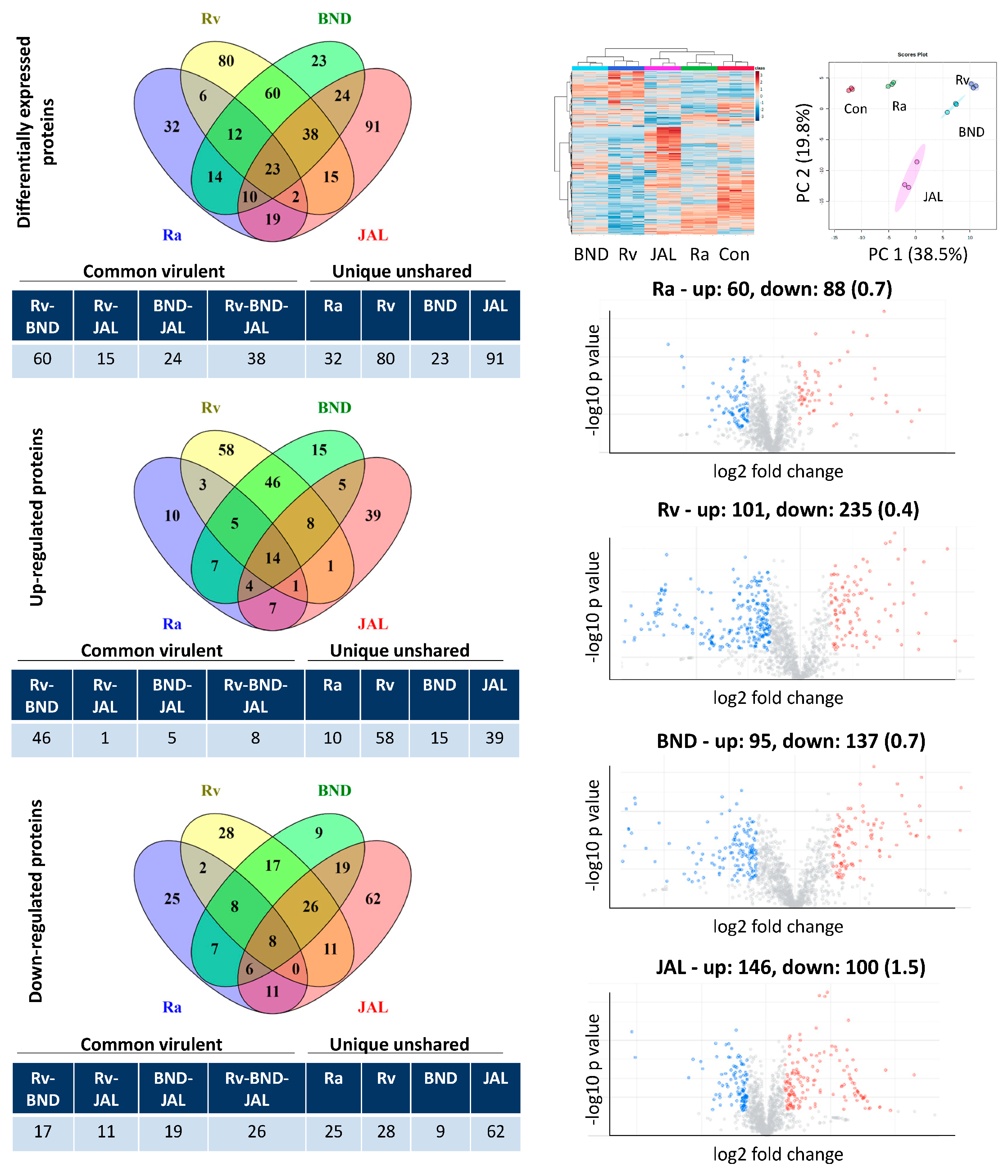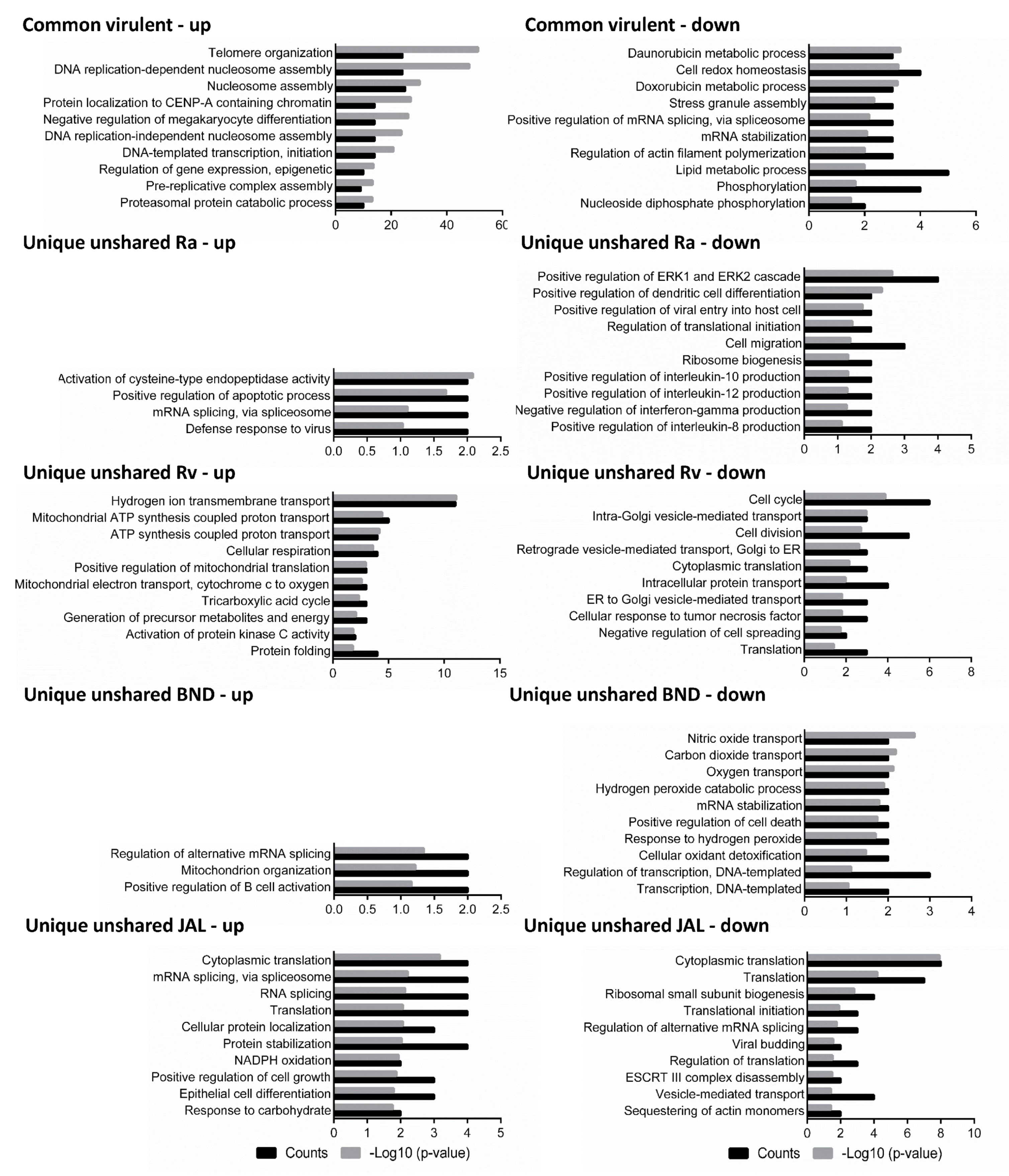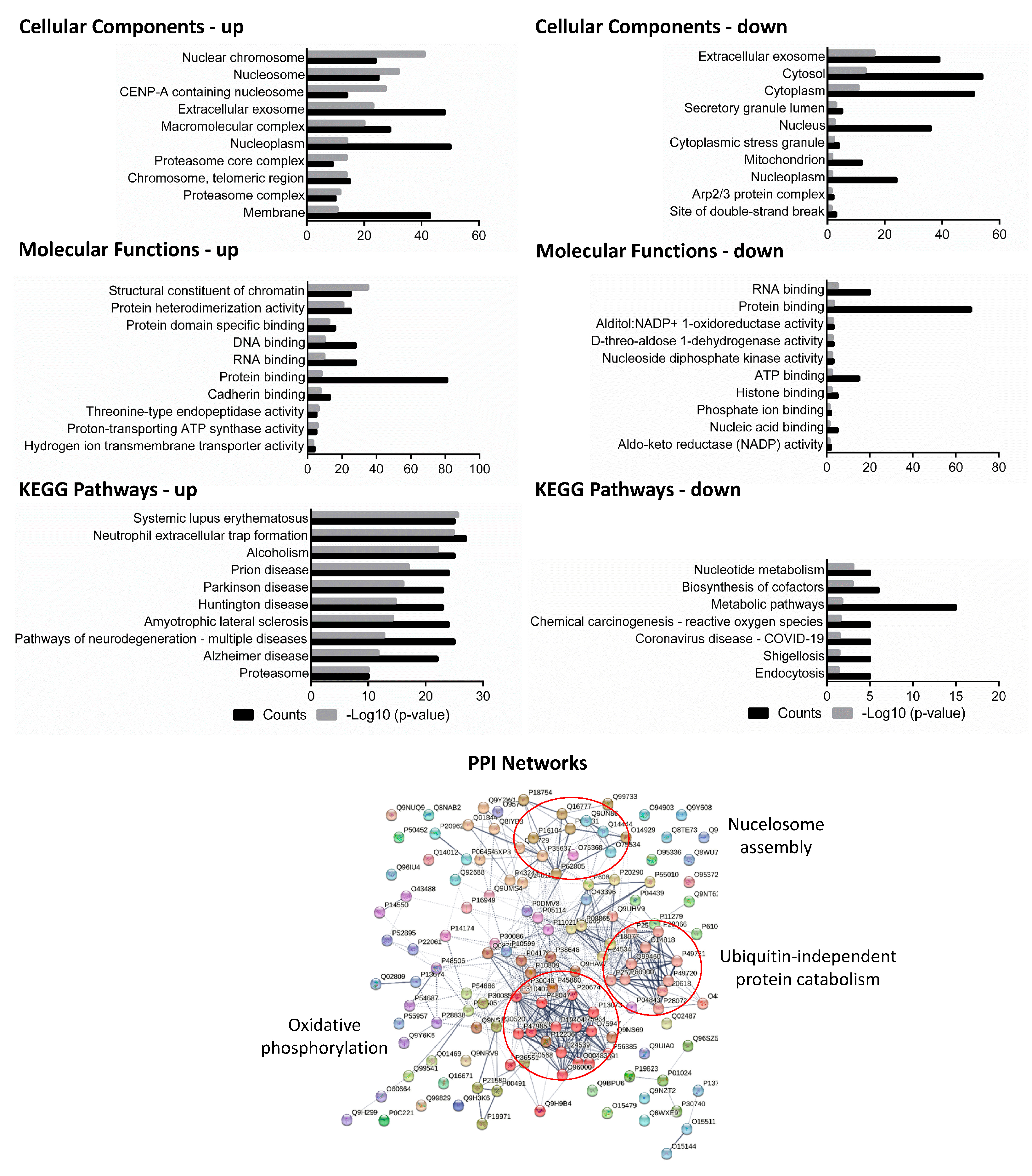Temporal Profiling of Host Proteome against Different M. tuberculosis Strains Reveals Delayed Epigenetic Orchestration
Abstract
1. Introduction
2. Materials and Methods
2.1. Cell Culture
2.2. Mycobacterial Infection and Proteomic Sample Preparation
2.3. Data-Dependent Acquisition (DDA) and Data-Independent Acquisition (DIA) Using NanoLC-MS/MS
2.4. Spectral Library Generation and Quality Control
2.5. SWATH-MS and Data Processing
2.6. Statistical and Bioinformatics Analyses
3. Results
3.1. Differential Proteome Analysis of Uninfected and Infected Macrophage-like Cells
3.2. Temporal Proteomic Response of Macrophages against MTB
4. Discussion
5. Conclusions
Supplementary Materials
Author Contributions
Funding
Data Availability Statement
Conflicts of Interest
References
- World Health Organization. Global Tuberculosis Report 2013; World Health Organization: Geneva, Switzerland, 2013; ISBN 978-92-4-156465-6. [Google Scholar]
- Sandhu, G.K. Tuberculosis: Current Situation, Challenges and Overview of Its Control Programs in India. J. Glob. Infect. Dis. 2011, 3, 143–150. [Google Scholar] [CrossRef] [PubMed]
- Mahajan, R. Bedaquiline: First FDA-Approved Tuberculosis Drug in 40 Years. Int. J. Appl. Basic Med. Res. 2013, 3, 1–2. [Google Scholar] [CrossRef] [PubMed]
- Smith, I. Mycobacterium Tuberculosis Pathogenesis and Molecular Determinants of Virulence. Clin. Microbiol. Rev. 2003, 16, 463–496. [Google Scholar] [CrossRef] [PubMed]
- Pai, M.; Behr, M.A.; Dowdy, D.; Dheda, K.; Divangahi, M.; Boehme, C.C.; Ginsberg, A.; Swaminathan, S.; Spigelman, M.; Getahun, H.; et al. Tuberculosis. Nat. Rev. Dis. Primer 2016, 2, 16076. [Google Scholar] [CrossRef]
- Natarajan, A.; Beena, P.M.; Devnikar, A.V.; Mali, S. A Systemic Review on Tuberculosis. Indian J. Tuberc. 2020, 67, 295–311. [Google Scholar] [CrossRef]
- Madden, K.; Liang, Y.C.; Rajabalee, N.; Alvarez, G.G.; Sun, J. Surveying the Epigenetic Landscape of Tuberculosis in Alveolar Macrophages. Infect. Immun. 2022, 90, e00522-21. [Google Scholar] [CrossRef]
- Fatima, S.; Kumari, A.; Agarwal, M.; Pahuja, I.; Yadav, V.; Dwivedi, V.P.; Bhaskar, A. Epigenetic Code during Mycobacterial Infections: Therapeutic Implications for Tuberculosis. FEBS J. 2022, 289, 4172–4191. [Google Scholar] [CrossRef]
- Hoffmann, E.; Machelart, A.; Song, O.-R.; Brodin, P. Proteomics of Mycobacterium Infection: Moving towards a Better Understanding of Pathogen-Driven Immunomodulation. Front. Immunol. 2018, 9, 86. [Google Scholar] [CrossRef]
- Dutta, N.K.; Bandyopadhyay, N.; Veeramani, B.; Lamichhane, G.; Karakousis, P.C.; Bader, J.S. Systems Biology-Based Identification of Mycobacterium Tuberculosis Persistence Genes in Mouse Lungs. mBio 2014, 5, e01066-13. [Google Scholar] [CrossRef]
- Chatterjee, A.; Saranath, D.; Bhatter, P.; Mistry, N. Global Transcriptional Profiling of Longitudinal Clinical Isolates of Mycobacterium Tuberculosis Exhibiting Rapid Accumulation of Drug Resistance. PLoS ONE 2013, 8, e54717. [Google Scholar] [CrossRef][Green Version]
- Li, H.; Wei, S.; Fang, Y.; Li, M.; Li, X.; Li, Z.; Zhang, J.; Zhu, G.; Li, C.; Bi, L.; et al. Quantitative Proteomic Analysis of Host Responses Triggered by Mycobacterium Tuberculosis Infection in Human Macrophage Cells. Acta Biochim. Biophys. Sin. 2017, 49, 835–844. [Google Scholar] [CrossRef] [PubMed]
- Kaushik, A.; Bandyopadhyay, S.; Porwal, C.; Srinivasan, A.; Rukmangadachar, L.A.; Hariprasad, G.; Kola, S.; Kataria, J.; Singh, U.B. 2D-DIGE Based Urinary Proteomics and Functional Enrichment Studies to Reveal Novel Mycobacterium Tuberculosis and Human Protein Biomarker Candidates for Pulmonary Tuberculosis. Biochem. Biophys. Res. Commun. 2022, 619, 15–21. [Google Scholar] [CrossRef] [PubMed]
- Devasundaram, S.; Gopalan, A.; Das, S.D.; Raja, A. Proteomics Analysis of Three Different Strains of Mycobacterium Tuberculosis under In Vitro Hypoxia and Evaluation of Hypoxia Associated Antigen’s Specific Memory T Cells in Healthy Household Contacts. Front. Microbiol. 2016, 7, 1275. [Google Scholar] [CrossRef][Green Version]
- Kumar, A.; Midha, M.K.; Rao, K.V. THP1 Proteomics in Response to Mycobacterium Tuberculosis Infection. Data Brief 2021, 35, 106803. [Google Scholar] [CrossRef] [PubMed]
- Mehrotra, T.; Konar, D.; Pragasam, A.K.; Kumar, S.; Jana, P.; Babele, P.; Paul, D.; Purohit, A.; Tanwar, S.; Bakshi, S.; et al. Antimicrobial Resistance Heterogeneity among Multidrug-Resistant Gram-Negative Pathogens: Phenotypic, Genotypic, and Proteomic Analysis. Proc. Natl. Acad. Sci. USA 2023, 120, e2305465120. [Google Scholar] [CrossRef]
- Midha, M.K.; Campbell, D.S.; Kapil, C.; Kusebauch, U.; Hoopmann, M.R.; Bader, S.L.; Moritz, R.L. DIALib-QC an Assessment Tool for Spectral Libraries in Data-Independent Acquisition Proteomics. Nat. Commun. 2020, 11, 5251. [Google Scholar] [CrossRef]
- Nesvizhskii, A.I.; Keller, A.; Kolker, E.; Aebersold, R. A Statistical Model for Identifying Proteins by Tandem Mass Spectrometry. Anal. Chem. 2003, 75, 4646–4658. [Google Scholar] [CrossRef]
- Sherman, B.T.; Hao, M.; Qiu, J.; Jiao, X.; Baseler, M.W.; Lane, H.C.; Imamichi, T.; Chang, W. DAVID: A Web Server for Functional Enrichment Analysis and Functional Annotation of Gene Lists (2021 Update). Nucleic Acids Res. 2022, 50, W216–W221. [Google Scholar] [CrossRef]
- Szklarczyk, D.; Franceschini, A.; Kuhn, M.; Simonovic, M.; Roth, A.; Minguez, P.; Doerks, T.; Stark, M.; Muller, J.; Bork, P.; et al. The STRING Database in 2011: Functional Interaction Networks of Proteins, Globally Integrated and Scored. Nucleic Acids Res. 2011, 39, D561–D568. [Google Scholar] [CrossRef]
- Data-Independent Acquisition-Based SWATH-MS for Quantitative Proteomics: A Tutorial—PMC. Available online: https://www.ncbi.nlm.nih.gov/pmc/articles/PMC6088389/ (accessed on 19 August 2023).
- Hingley-Wilson, S.M.; Sambandamurthy, V.K.; Jacobs, W.R. Survival Perspectives from the World’s Most Successful Pathogen, Mycobacterium Tuberculosis. Nat. Immunol. 2003, 4, 949–955. [Google Scholar] [CrossRef]
- The Gene Ontology Consortium. The Gene Ontology Resource: 20 Years and Still GOing Strong. Nucleic Acids Res. 2019, 47, D330–D338. [Google Scholar] [CrossRef] [PubMed]
- Downregulation of Vimentin in Macrophages Infected with Live Mycobacterium Tuberculosis Is Mediated by Reactive Oxygen Species|Scientific Reports. Available online: https://www.nature.com/articles/srep21526 (accessed on 17 August 2023).
- Shastri, M.D.; Shukla, S.D.; Chong, W.C.; Dua, K.; Peterson, G.M.; Patel, R.P.; Hansbro, P.M.; Eri, R.; O’Toole, R.F. Role of Oxidative Stress in the Pathology and Management of Human Tuberculosis. Oxid. Med. Cell. Longev. 2018, 2018, 7695364. [Google Scholar] [CrossRef] [PubMed]
- Guillén-Boixet, J.; Kopach, A.; Holehouse, A.S.; Wittmann, S.; Jahnel, M.; Schlüßler, R.; Kim, K.; Trussina, I.R.E.A.; Wang, J.; Mateju, D.; et al. RNA-Induced Conformational Switching and Clustering of G3BP Drive Stress Granule Assembly by Condensation. Cell 2020, 181, 346–361. [Google Scholar] [CrossRef] [PubMed]
- Higashi, S.; Kabuta, T.; Nagai, Y.; Tsuchiya, Y.; Akiyama, H.; Wada, K. TDP-43 Associates with Stalled Ribosomes and Contributes to Cell Survival during Cellular Stress. J. Neurochem. 2013, 126, 288–300. [Google Scholar] [CrossRef]
- DiScipio, R.G.; Daffern, P.J.; Schraufstätter, I.U.; Sriramarao, P. Human Polymorphonuclear Leukocytes Adhere to Complement Factor H through an Interaction That Involves AlphaMbeta2 (CD11b/CD18). J. Immunol. Baltim. Md 1950 1998, 160, 4057–4066. [Google Scholar]
- Patouret, R. The Nuclear Transport Protein Importin-5: A Promising Target in Oncology and Virology. Chimia 2021, 75, 319–322. [Google Scholar] [CrossRef]
- Nuclear ARP2/3 Drives DNA Break Clustering for Homology-Directed Repair—PubMed. Available online: https://pubmed.ncbi.nlm.nih.gov/29925947/ (accessed on 3 August 2023).
- Weichenrieder, O.; Wild, K.; Strub, K.; Cusack, S. Structure and Assembly of the Alu Domain of the Mammalian Signal Recognition Particle. Nature 2000, 408, 167–173. [Google Scholar] [CrossRef]
- Wang, A.; Conicella, A.E.; Schmidt, H.B.; Martin, E.W.; Rhoads, S.N.; Reeb, A.N.; Nourse, A.; Ramirez Montero, D.; Ryan, V.H.; Rohatgi, R.; et al. A Single N-Terminal Phosphomimic Disrupts TDP-43 Polymerization, Phase Separation, and RNA Splicing. EMBO J. 2018, 37, e97452. [Google Scholar] [CrossRef]
- Giddey, A.D.; de Kock, E.; Nakedi, K.C.; Garnett, S.; Nel, A.J.M.; Soares, N.C.; Blackburn, J.M. A Temporal Proteome Dynamics Study Reveals the Molecular Basis of Induced Phenotypic Resistance in Mycobacterium Smegmatis at Sub-Lethal Rifampicin Concentrations. Sci. Rep. 2017, 7, 43858. [Google Scholar] [CrossRef]
- Proteome Profiling of Mycobacterium Tuberculosis Cells Exposed to Nitrosative Stress|ACS Omega. Available online: https://pubs.acs.org/doi/10.1021/acsomega.1c05923 (accessed on 17 August 2023).
- Esterhuyse, M.M.; Weiner, J.; Caron, E.; Loxton, A.G.; Iannaccone, M.; Wagman, C.; Saikali, P.; Stanley, K.; Wolski, W.E.; Mollenkopf, H.-J.; et al. Epigenetics and Proteomics Join Transcriptomics in the Quest for Tuberculosis Biomarkers. mBio 2015, 6, e01187-15. [Google Scholar] [CrossRef]
- Ayyanathan, K.; Lechner, M.S.; Bell, P.; Maul, G.G.; Schultz, D.C.; Yamada, Y.; Tanaka, K.; Torigoe, K.; Rauscher, F.J. Regulated Recruitment of HP1 to a Euchromatic Gene Induces Mitotically Heritable, Epigenetic Gene Silencing: A Mammalian Cell Culture Model of Gene Variegation. Genes Dev. 2003, 17, 1855–1869. [Google Scholar] [CrossRef]
- Garfinkel, B.P.; Melamed-Book, N.; Anuka, E.; Bustin, M.; Orly, J. HP1BP3 Is a Novel Histone H1 Related Protein with Essential Roles in Viability and Growth. Nucleic Acids Res. 2015, 43, 2074–2090. [Google Scholar] [CrossRef]
- Munemasa, Y.; Suzuki, T.; Aizawa, K.; Miyamoto, S.; Imai, Y.; Matsumura, T.; Horikoshi, M.; Nagai, R. Promoter Region-Specific Histone Incorporation by the Novel Histone Chaperone ANP32B and DNA-Binding Factor KLF5. Mol. Cell. Biol. 2008, 28, 1171–1181. [Google Scholar] [CrossRef]
- Yang, X.; Sun, X.; Lu, B.; Wang, Q.; Huang, Z. ANP32A Regulates Histone 3 Acetylation and Promotes Leukemogenesis in AML. Blood 2016, 128, 3917. [Google Scholar] [CrossRef]
- Barbier-Torres, L.; Beraza, N.; Fernández-Tussy, P.; Lopitz-Otsoa, F.; Fernández-Ramos, D.; Zubiete-Franco, I.; Varela-Rey, M.; Delgado, T.C.; Gutiérrez, V.; Anguita, J.; et al. Histone Deacetylase 4 Promotes Cholestatic Liver Injury in the Absence of Prohibitin-1. Hepatology 2015, 62, 1237–1248. [Google Scholar] [CrossRef]
- Matsumura, K.; Takaki, S.; Kirikae, T. Mycobacterial Protein PE_PGRS30 Induces Macrophage Apoptosis through Prohibitin 2 Mitochondrial Function Interference. Front. Microbiol. 2023, 14, 1080369. [Google Scholar] [CrossRef]
- Pennini, M.E.; Pai, R.K.; Schultz, D.C.; Boom, W.H.; Harding, C.V. Mycobacterium Tuberculosis 19-KDa Lipoprotein Inhibits IFN-Gamma-Induced Chromatin Remodeling of MHC2TA by TLR2 and MAPK Signaling. J. Immunol. 2006, 176, 4323–4330. [Google Scholar] [CrossRef]
- Ikura, T.; Tashiro, S.; Kakino, A.; Shima, H.; Jacob, N.; Amunugama, R.; Yoder, K.; Izumi, S.; Kuraoka, I.; Tanaka, K.; et al. DNA Damage-Dependent Acetylation and Ubiquitination of H2AX Enhances Chromatin Dynamics. Mol. Cell. Biol. 2007, 27, 7028–7040. [Google Scholar] [CrossRef]
- Chen, Y.-C.; Hsiao, C.-C.; Chen, T.-W.; Wu, C.-C.; Chao, T.-Y.; Leung, S.-Y.; Eng, H.-L.; Lee, C.-P.; Wang, T.-Y.; Lin, M.-C. Whole Genome DNA Methylation Analysis of Active Pulmonary Tuberculosis Disease Identifies Novel Epigenotypes: PARP9/MiR-505/RASGRP4/GNG12 Gene Methylation and Clinical Phenotypes. Int. J. Mol. Sci. 2020, 21, 3180. [Google Scholar] [CrossRef]
- Jose, L.; Ramachandran, R.; Bhagavat, R.; Gomez, R.L.; Chandran, A.; Raghunandanan, S.; Omkumar, R.V.; Chandra, N.; Mundayoor, S.; Kumar, R.A. Hypothetical Protein Rv3423.1 of Mycobacterium Tuberculosis Is a Histone Acetyltransferase. FEBS J. 2016, 283, 265–281. [Google Scholar] [CrossRef]
- Chen, Y.-C.; Chao, T.-Y.; Leung, S.-Y.; Chen, C.-J.; Wu, C.-C.; Fang, W.-F.; Wang, Y.-H.; Chang, H.-C.; Wang, T.-Y.; Lin, Y.-Y.; et al. Histone H3K14 Hypoacetylation and H3K27 Hypermethylation along with HDAC1 Up-Regulation and KDM6B down-Regulation Are Associated with Active Pulmonary Tuberculosis Disease. Am. J. Transl. Res. 2017, 9, 1943–1955. [Google Scholar] [PubMed]
- Madden, K.; El Hamra, R.; Berton, S.; Felker, J.; Alvarez, G.G.; Blais, A.; Sun, J. Mycobacterium Tuberculosis Infection Triggers Epigenetic Changes That Are Enriched in a Type I IFN Signature. microLife 2023, 4, uqad006. [Google Scholar] [CrossRef] [PubMed]
- Rhoades, E.R.; Ullrich, H.J. How to Establish a Lasting Relationship with Your Host: Lessons Learned from Mycobacterium Spp. Immunol. Cell Biol. 2000, 78, 301–310. [Google Scholar] [CrossRef]
- Ghosh, A.; Tousif, S.; Bhattacharya, D.; Samuchiwal, S.K.; Bhalla, K.; Tharad, M.; Kumar, S.; Prakash, P.; Kumar, P.; Das, G.; et al. Expression of the ARPC4 Subunit of Human Arp2/3 Severely Affects Mycobacterium Tuberculosis Growth and Suppresses Immunogenic Response in Murine Macrophages. PLoS ONE 2013, 8, e69949. [Google Scholar] [CrossRef]
- Bussi, C.; Gutierrez, M.G. Mycobacterium Tuberculosis Infection of Host Cells in Space and Time. FEMS Microbiol. Rev. 2019, 43, 341–361. [Google Scholar] [CrossRef] [PubMed]
- Clemens, D.L.; Horwitz, M.A. The Mycobacterium Tuberculosis Phagosome Interacts with Early Endosomes and Is Accessible to Exogenously Administered Transferrin. J. Exp. Med. 1996, 184, 1349–1355. [Google Scholar] [CrossRef] [PubMed]
- Ferrari, G.; Langen, H.; Naito, M.; Pieters, J. A Coat Protein on Phagosomes Involved in the Intracellular Survival of Mycobacteria. Cell 1999, 97, 435–447. [Google Scholar] [CrossRef]
- Kumar, M.; Roe, K.; Orillo, B.; Muruve, D.A.; Nerurkar, V.R.; Gale, M.; Verma, S. Inflammasome Adaptor Protein Apoptosis-Associated Speck-Like Protein Containing CARD (ASC) Is Critical for the Immune Response and Survival in West Nile Virus Encephalitis. J. Virol. 2013, 87, 3655–3667. [Google Scholar] [CrossRef]
- Cui, Y.; Zhao, D.; Barrow, P.A.; Zhou, X. The Endoplasmic Reticulum Stress Response: A Link with Tuberculosis? Tuberc. Edinb. Scotl. 2016, 97, 52–56. [Google Scholar] [CrossRef]



| H37Ra | H37Rv | BND433 | JAL2287 | |||||||||
|---|---|---|---|---|---|---|---|---|---|---|---|---|
| Time | Up | Down | U/D | Up | Down | U/D | Up | Down | U/D | Up | Down | U/D |
| 6 h | 113 | 110 | 1.0 | 25 | 104 | 0.2 | 55 | 99 | 0.5 | 50 | 292 | 0.2 |
| 18 h | 60 | 88 | 0.7 | 101 | 235 | 0.4 | 95 | 137 | 0.7 | 146 | 100 | 1.5 |
| 30 h | 113 | 155 | 0.7 | 78 | 144 | 0.5 | 86 | 118 | 0.7 | 156 | 184 | 0.8 |
| 42 h | 72 | 287 | 0.2 | 114 | 394 | 0.3 | 112 | 408 | 0.3 | 83 | 337 | 0.2 |
Disclaimer/Publisher’s Note: The statements, opinions and data contained in all publications are solely those of the individual author(s) and contributor(s) and not of MDPI and/or the editor(s). MDPI and/or the editor(s) disclaim responsibility for any injury to people or property resulting from any ideas, methods, instructions or products referred to in the content. |
© 2023 by the authors. Licensee MDPI, Basel, Switzerland. This article is an open access article distributed under the terms and conditions of the Creative Commons Attribution (CC BY) license (https://creativecommons.org/licenses/by/4.0/).
Share and Cite
Babele, P.; Midha, M.K.; Rao, K.V.S.; Kumar, A. Temporal Profiling of Host Proteome against Different M. tuberculosis Strains Reveals Delayed Epigenetic Orchestration. Microorganisms 2023, 11, 2998. https://doi.org/10.3390/microorganisms11122998
Babele P, Midha MK, Rao KVS, Kumar A. Temporal Profiling of Host Proteome against Different M. tuberculosis Strains Reveals Delayed Epigenetic Orchestration. Microorganisms. 2023; 11(12):2998. https://doi.org/10.3390/microorganisms11122998
Chicago/Turabian StyleBabele, Prabhakar, Mukul K. Midha, Kanury V. S. Rao, and Ajay Kumar. 2023. "Temporal Profiling of Host Proteome against Different M. tuberculosis Strains Reveals Delayed Epigenetic Orchestration" Microorganisms 11, no. 12: 2998. https://doi.org/10.3390/microorganisms11122998
APA StyleBabele, P., Midha, M. K., Rao, K. V. S., & Kumar, A. (2023). Temporal Profiling of Host Proteome against Different M. tuberculosis Strains Reveals Delayed Epigenetic Orchestration. Microorganisms, 11(12), 2998. https://doi.org/10.3390/microorganisms11122998






